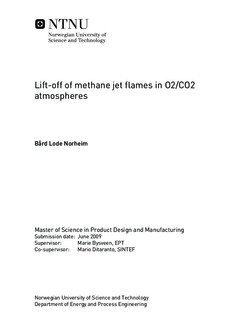Lift-off of methane jet flames in O2/CO2 atmospheres
Master thesis
Permanent lenke
http://hdl.handle.net/11250/234269Utgivelsesdato
2009Metadata
Vis full innførselSamlinger
Sammendrag
Turbulent jet diffusion flames and flame lift-off have been the topic of a great deal of research due to its complexity in combining both turbulent flow and combustion. The mechanisms controlling flame lift-off however, are not yet properly understood and is still an active field of research. In this report, experimental studies of lift-off characteristics for oxy-fuel combustion with methane have been conducted for oxygen concentrations ranging from 34% to 50%. Three different fuel nozzles were used, with diameters of of 2mm, 4mm and 5mm. In addition to oxy-fuel combustion, experiments were carried out in air, and oxygen enriched air, as a reference case.The goal has been to observe how oxy-fuel flames differ from regular diffusion flames burning in air with regards to lift-off. Lift-off heights and velocities were found to be strongly dependent on oxygen concentration, with increasing concentration causing shorter lift-off heights and higher lift-off velocities. It was also discovered that the combustion chamber wall temperature seemed to have a great impact on flame stability. Higher wall temperatures had a stabilizing effect on the flame, probably due to lower heat loss and higher burning velocities.Results from the air cases were compared to data from other studies, and were found to deviate some, most likely due to the presence of co-flow.
